Abstract
1. The possible involvement of nitric oxide (NO) in the induction and expression of morphine tolerance and dependence was studied in mice. A two-day repeated injection regimen was used to induce morphine tolerance and dependence. Tolerance was assessed by the tail flick test and physical dependence by naloxone challenge, on the third day. 2. Two days pretreatment with L-arginine (20 mg kg-1, twice daily) or D-NG-nitro arginine methyl ester (D-NAME, 20 mg kg-1, twice daily) alone had no effect on subsequent morphine antinociception. L-NG-monomethyl arginine (L-NMMA, 10 mg kg-1, twice daily) for two days led to a slight increase (not statistically significant) in morphine antinociception; while L-NG-nitro arginine methyl ester (L-NAME, 10 mg kg-1, twice daily) for two days led to attenuation of morphine analgesia. None of the animals treated with these drugs alone showed signs characteristic of the opioid withdrawal syndrome upon naloxone challenge. 3. Induction phase L-arginine slowed the development of opioid tolerance and physical dependence, while L-NAME and L-NMMA led to a higher degree of tolerance but had no effect on the development of physical dependence. 4. L-Arginine and D-NAME had no effect on the expression of morphine tolerance and physical dependence. Expression phase L-NAME and L-NMMA, on the other hand, attenuated morphine tolerance and reduced the incidence of withdrawal signs. 5. NO may, therefore, play a role in both phases of morphine tolerance and dependence: elevation of NO levels during the induction phase delays the development of opioid tolerance/dependence, while inhibition of NO synthase accelerates the development of tolerance. Inhibition of NO attenuates the expression of both tolerance and physical dependence.
Full text
PDF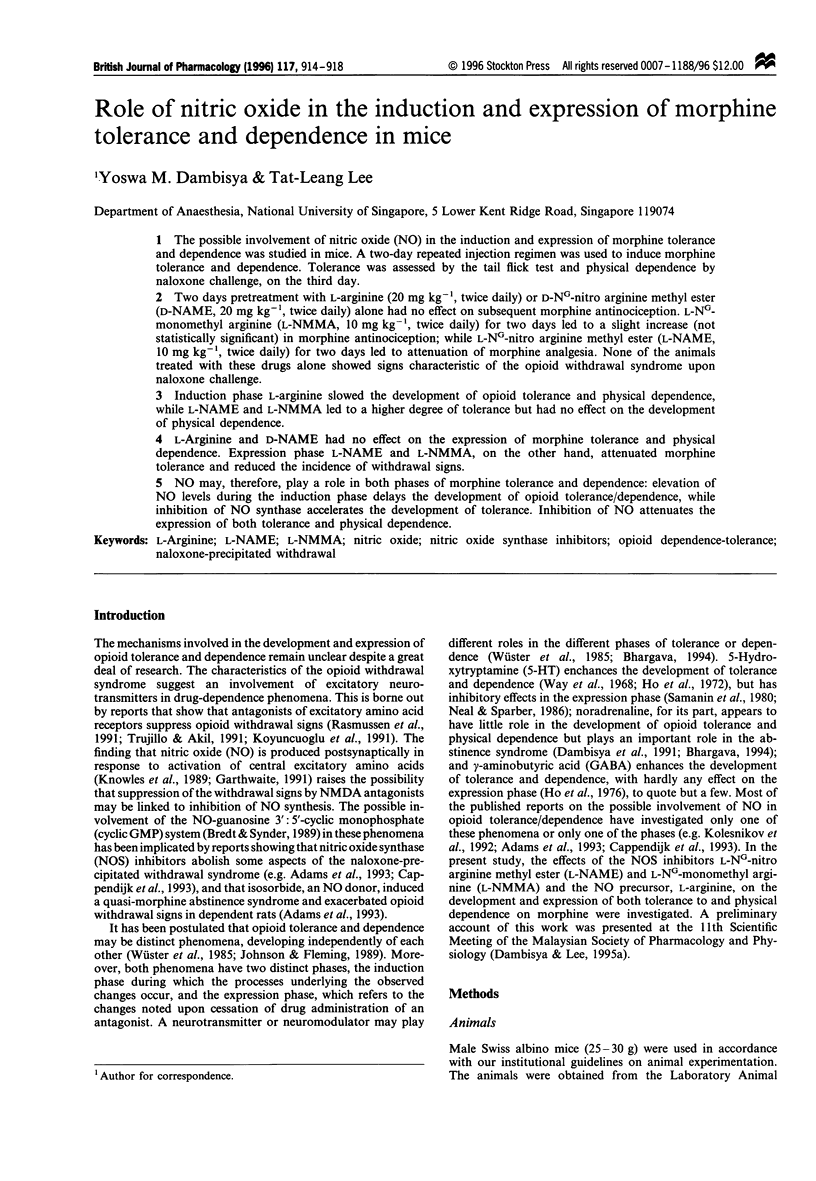
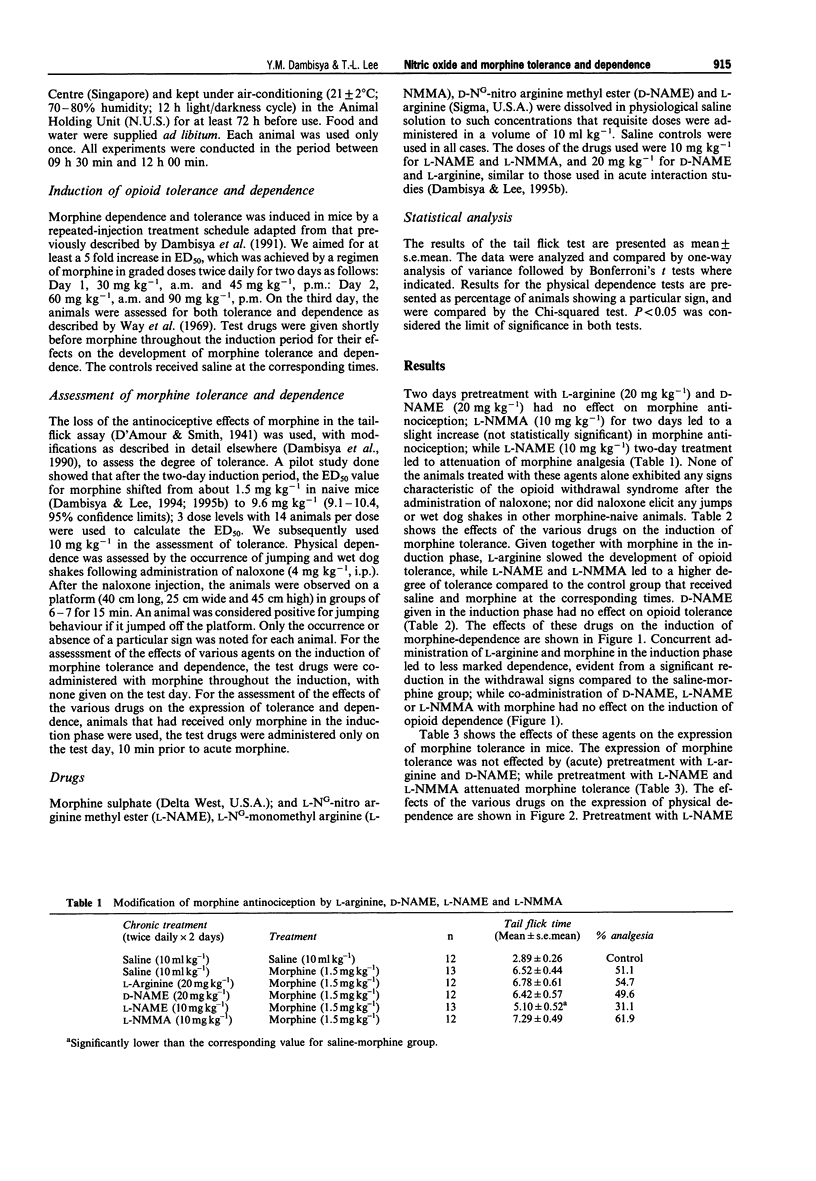
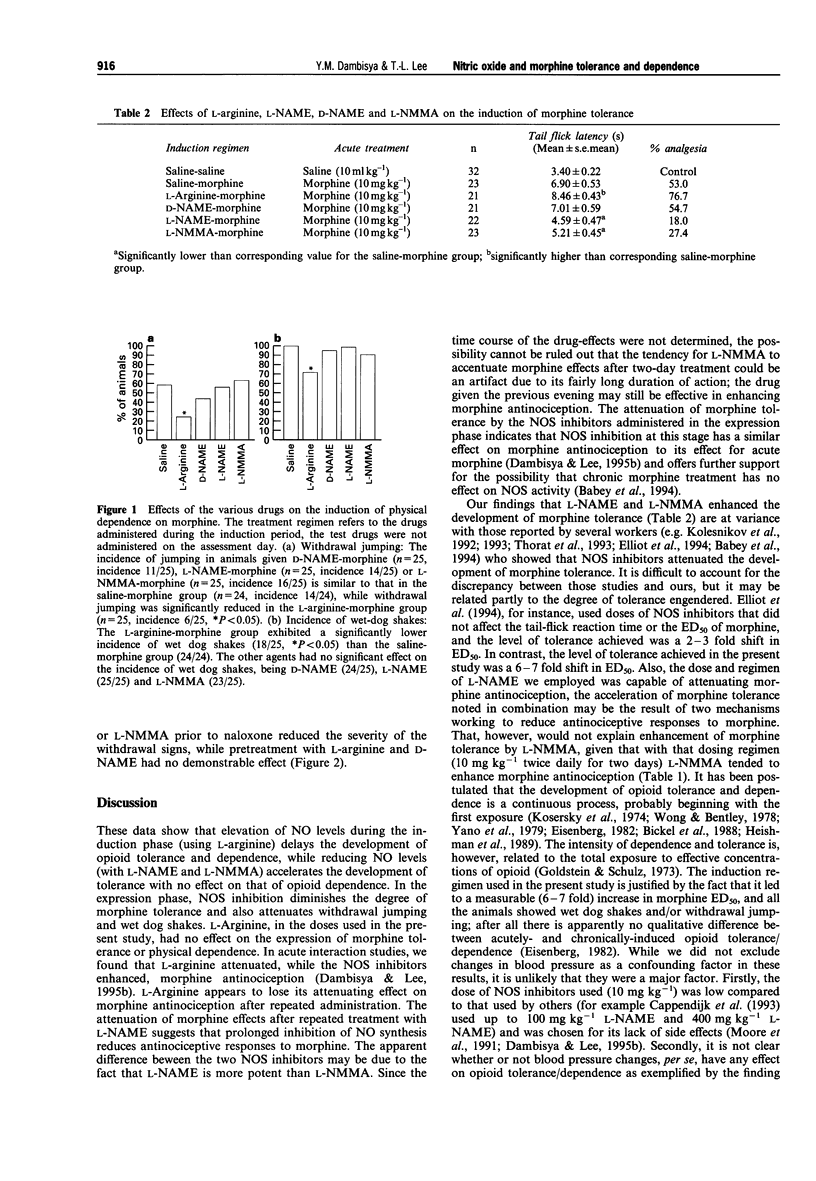
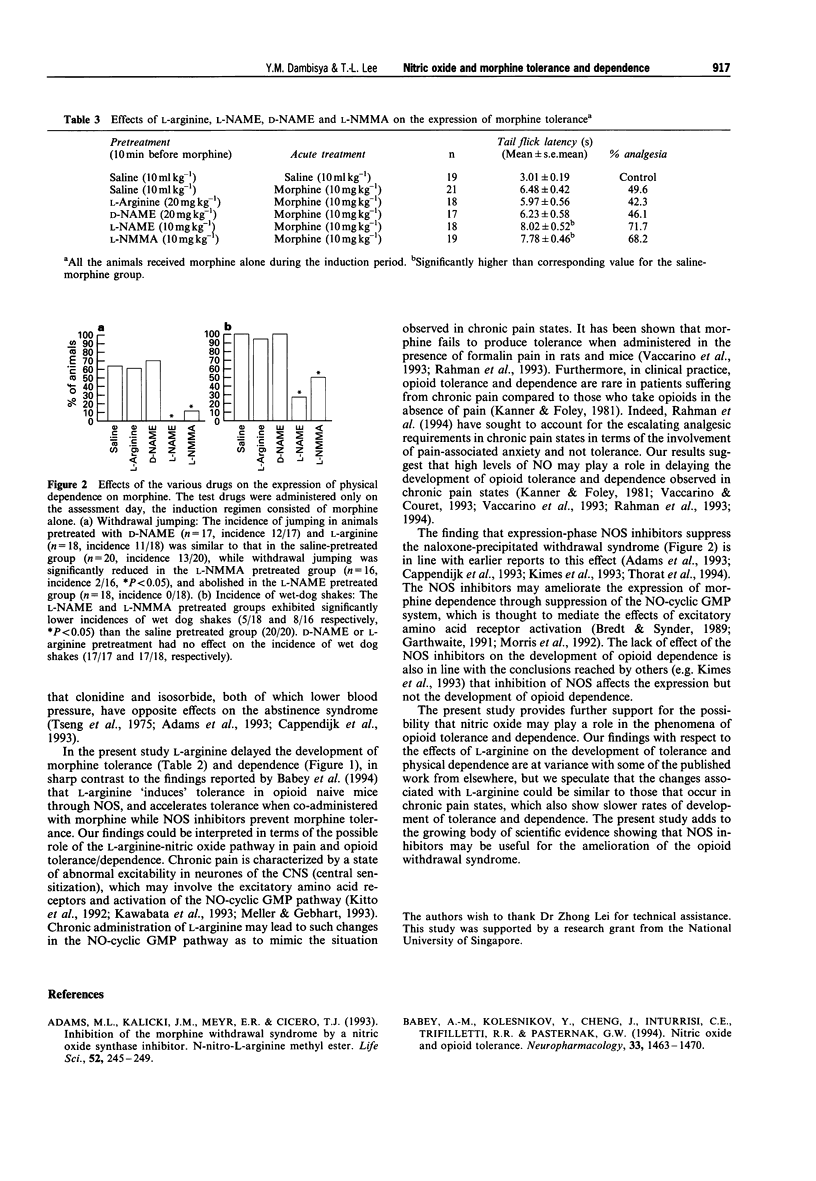
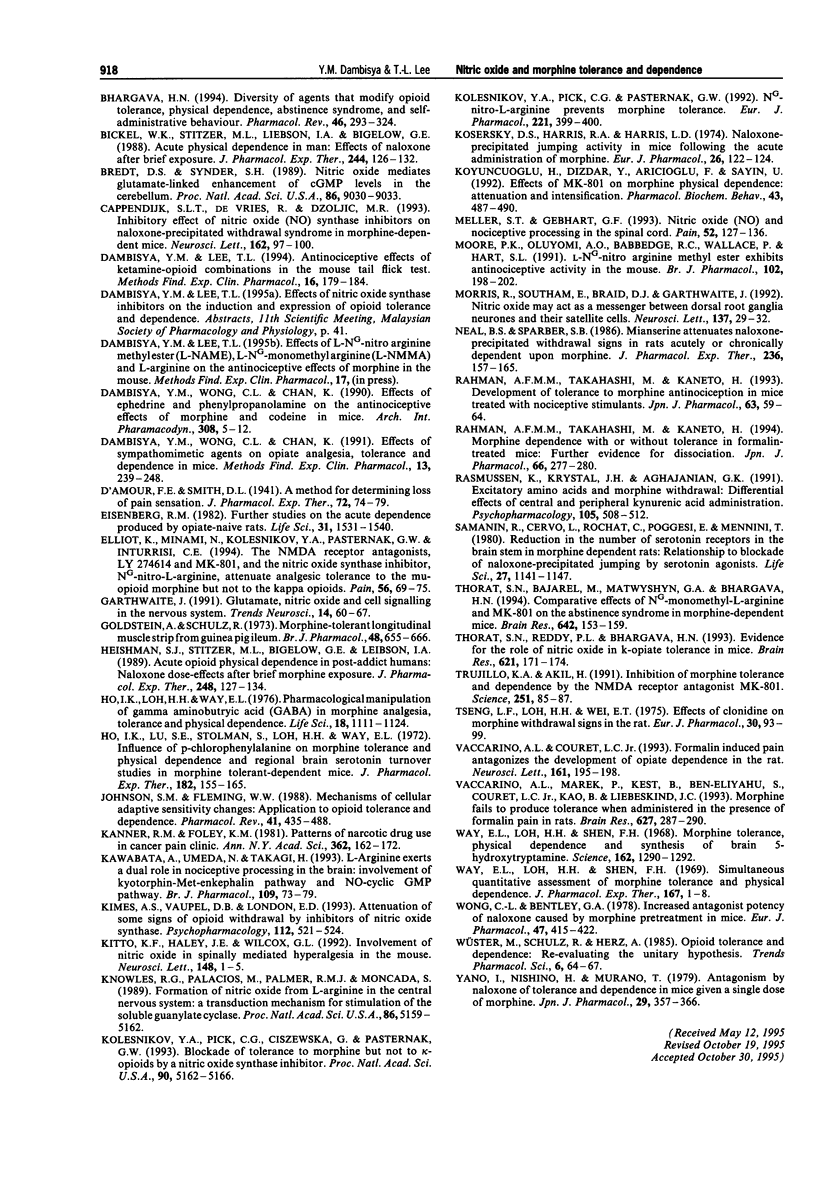
Selected References
These references are in PubMed. This may not be the complete list of references from this article.
- Babey A. M., Kolesnikov Y., Cheng J., Inturrisi C. E., Trifilletti R. R., Pasternak G. W. Nitric oxide and opioid tolerance. Neuropharmacology. 1994 Nov;33(11):1463–1470. doi: 10.1016/0028-3908(94)90050-7. [DOI] [PubMed] [Google Scholar]
- Bhargava H. N. Diversity of agents that modify opioid tolerance, physical dependence, abstinence syndrome, and self-administrative behavior. Pharmacol Rev. 1994 Sep;46(3):293–324. [PubMed] [Google Scholar]
- Bickel W. K., Stitzer M. L., Liebson I. A., Bigelow G. E. Acute physical dependence in man: effects of naloxone after brief morphine exposure. J Pharmacol Exp Ther. 1988 Jan;244(1):126–132. [PubMed] [Google Scholar]
- Bredt D. S., Snyder S. H. Nitric oxide mediates glutamate-linked enhancement of cGMP levels in the cerebellum. Proc Natl Acad Sci U S A. 1989 Nov;86(22):9030–9033. doi: 10.1073/pnas.86.22.9030. [DOI] [PMC free article] [PubMed] [Google Scholar]
- Cappendijk S. L., de Vries R., Dzoljic M. R. Inhibitory effect of nitric oxide (NO) synthase inhibitors on naloxone-precipitated withdrawal syndrome in morphine-dependent mice. Neurosci Lett. 1993 Nov 12;162(1-2):97–100. doi: 10.1016/0304-3940(93)90569-7. [DOI] [PubMed] [Google Scholar]
- Dambisya Y. M., Lee T. L. Antinociceptive effects of ketamine-opioid combinations in the mouse tail flick test. Methods Find Exp Clin Pharmacol. 1994 Apr;16(3):179–184. [PubMed] [Google Scholar]
- Dambisya Y. M., Wong C. L., Chan K. Effects of ephedrine and phenylpropanolamine on the antinociceptive effects of morphine and codeine in mice. Arch Int Pharmacodyn Ther. 1990 Nov-Dec;308:5–12. [PubMed] [Google Scholar]
- Dambisya Y. M., Wong C. L., Chan K. Effects of sympathomimetic agents on opiate analgesia, tolerance and dependence in mice. Methods Find Exp Clin Pharmacol. 1991 May;13(4):239–248. [PubMed] [Google Scholar]
- Eisenberg R. M. Further studies on the acute dependence produced by morphine in opiate naive rats. Life Sci. 1982 Oct 11;31(15):1531–1540. doi: 10.1016/0024-3205(82)90043-1. [DOI] [PubMed] [Google Scholar]
- Elliott K., Minami N., Kolesnikov Y. A., Pasternak G. W., Inturrisi C. E. The NMDA receptor antagonists, LY274614 and MK-801, and the nitric oxide synthase inhibitor, NG-nitro-L-arginine, attenuate analgesic tolerance to the mu-opioid morphine but not to kappa opioids. Pain. 1994 Jan;56(1):69–75. doi: 10.1016/0304-3959(94)90151-1. [DOI] [PubMed] [Google Scholar]
- Garthwaite J. Glutamate, nitric oxide and cell-cell signalling in the nervous system. Trends Neurosci. 1991 Feb;14(2):60–67. doi: 10.1016/0166-2236(91)90022-m. [DOI] [PubMed] [Google Scholar]
- Goldstein A., Schulz R. Morphine-tolerant longitudinal muscle strip from guinea-pig ileum. Br J Pharmacol. 1973 Aug;48(4):655–666. doi: 10.1111/j.1476-5381.1973.tb08254.x. [DOI] [PMC free article] [PubMed] [Google Scholar]
- Heishman S. J., Stitzer M. L., Bigelow G. E., Liebson I. A. Acute opioid physical dependence in postaddict humans: naloxone dose effects after brief morphine exposure. J Pharmacol Exp Ther. 1989 Jan;248(1):127–134. [PubMed] [Google Scholar]
- Ho I. K., Loh H. H., Way E. L. Pharmacological manipulation of gamma-aminobutyric acid (GABA) in morphine analgesia, tolerance and physical dependence. Life Sci. 1976 May 15;18(10):1111–1123. doi: 10.1016/0024-3205(76)90146-6. [DOI] [PubMed] [Google Scholar]
- Ho I. K., Lu S. E., Stolman S., Loh H. H., Way E. L. Influence of p-chlorophenylalanine on morphine tolerance and physical dependence and regional brain serotonin turnover studies in morphine tolerant-dependent mice. J Pharmacol Exp Ther. 1972 Jul;182(1):155–165. [PubMed] [Google Scholar]
- Johnson S. M., Fleming W. W. Mechanisms of cellular adaptive sensitivity changes: applications to opioid tolerance and dependence. Pharmacol Rev. 1989 Dec;41(4):435–488. [PubMed] [Google Scholar]
- Kanner R. M., Foley K. M. Patterns of narcotic drug use in a cancer pain clinic. Ann N Y Acad Sci. 1981;362:161–172. doi: 10.1111/j.1749-6632.1981.tb12804.x. [DOI] [PubMed] [Google Scholar]
- Kawabata A., Umeda N., Takagi H. L-arginine exerts a dual role in nociceptive processing in the brain: involvement of the kyotorphin-Met-enkephalin pathway and NO-cyclic GMP pathway. Br J Pharmacol. 1993 May;109(1):73–79. doi: 10.1111/j.1476-5381.1993.tb13533.x. [DOI] [PMC free article] [PubMed] [Google Scholar]
- Kimes A. S., Vaupel D. B., London E. D. Attenuation of some signs of opioid withdrawal by inhibitors of nitric oxide synthase. Psychopharmacology (Berl) 1993;112(4):521–524. doi: 10.1007/BF02244904. [DOI] [PubMed] [Google Scholar]
- Kitto K. F., Haley J. E., Wilcox G. L. Involvement of nitric oxide in spinally mediated hyperalgesia in the mouse. Neurosci Lett. 1992 Dec 14;148(1-2):1–5. doi: 10.1016/0304-3940(92)90790-e. [DOI] [PubMed] [Google Scholar]
- Knowles R. G., Palacios M., Palmer R. M., Moncada S. Formation of nitric oxide from L-arginine in the central nervous system: a transduction mechanism for stimulation of the soluble guanylate cyclase. Proc Natl Acad Sci U S A. 1989 Jul;86(13):5159–5162. doi: 10.1073/pnas.86.13.5159. [DOI] [PMC free article] [PubMed] [Google Scholar]
- Kolesnikov Y. A., Pick C. G., Ciszewska G., Pasternak G. W. Blockade of tolerance to morphine but not to kappa opioids by a nitric oxide synthase inhibitor. Proc Natl Acad Sci U S A. 1993 Jun 1;90(11):5162–5166. doi: 10.1073/pnas.90.11.5162. [DOI] [PMC free article] [PubMed] [Google Scholar]
- Kolesnikov Y. A., Pick C. G., Pasternak G. W. NG-nitro-L-arginine prevents morphine tolerance. Eur J Pharmacol. 1992 Oct 20;221(2-3):399–400. doi: 10.1016/0014-2999(92)90732-j. [DOI] [PubMed] [Google Scholar]
- Kosersky D. S., Harris R. A., Harris L. S. Naloxone-precipitated jumping activity in mice following the acute administration of morphine. Eur J Pharmacol. 1974 Apr;26(1):122–124. doi: 10.1016/0014-2999(74)90084-3. [DOI] [PubMed] [Google Scholar]
- Koyuncuoğlu H., Dizdar Y., Aricioğlu F., Sayin U. Effects of MK 801 on morphine physical dependence: attenuation and intensification. Pharmacol Biochem Behav. 1992 Oct;43(2):487–490. doi: 10.1016/0091-3057(92)90181-e. [DOI] [PubMed] [Google Scholar]
- Meller S. T., Gebhart G. F. Nitric oxide (NO) and nociceptive processing in the spinal cord. Pain. 1993 Feb;52(2):127–136. doi: 10.1016/0304-3959(93)90124-8. [DOI] [PubMed] [Google Scholar]
- Moore P. K., Oluyomi A. O., Babbedge R. C., Wallace P., Hart S. L. L-NG-nitro arginine methyl ester exhibits antinociceptive activity in the mouse. Br J Pharmacol. 1991 Jan;102(1):198–202. doi: 10.1111/j.1476-5381.1991.tb12153.x. [DOI] [PMC free article] [PubMed] [Google Scholar]
- Morris R., Southam E., Braid D. J., Garthwaite J. Nitric oxide may act as a messenger between dorsal root ganglion neurones and their satellite cells. Neurosci Lett. 1992 Mar 16;137(1):29–32. doi: 10.1016/0304-3940(92)90290-n. [DOI] [PubMed] [Google Scholar]
- Neal B. S., Sparber S. B. Mianserin attenuates naloxone-precipitated withdrawal signs in rats acutely or chronically dependent upon morphine. J Pharmacol Exp Ther. 1986 Jan;236(1):157–165. [PubMed] [Google Scholar]
- Rahman A. F., Takahashi M., Kaneto H. Development of tolerance to morphine antinociception in mice treated with nociceptive stimulants. Jpn J Pharmacol. 1993 Sep;63(1):59–64. doi: 10.1254/jjp.63.59. [DOI] [PubMed] [Google Scholar]
- Rahman A. F., Takahashi M., Kaneto H. Morphine dependence with or without tolerance in formalin-treated mice: further evidence for the dissociation. Jpn J Pharmacol. 1994 Oct;66(2):277–280. doi: 10.1254/jjp.66.277. [DOI] [PubMed] [Google Scholar]
- Rasmussen K., Krystal J. H., Aghajanian G. K. Excitatory amino acids and morphine withdrawal: differential effects of central and peripheral kynurenic acid administration. Psychopharmacology (Berl) 1991;105(4):508–512. doi: 10.1007/BF02244371. [DOI] [PubMed] [Google Scholar]
- Samanin R., Cervo L., Rochat C., Poggesi E., Mennini T. Reduction in the number of serotonin receptors in the brainstem of morphine dependent rats: relation to blockade of naloxone precipitated jumping by serotonin agonists. Life Sci. 1980 Sep 29;27(13):1141–1146. doi: 10.1016/0024-3205(80)90464-6. [DOI] [PubMed] [Google Scholar]
- Thorat S. N., Barjavel M. J., Matwyshyn G. A., Bhargava H. N. Comparative effects of NG-monomethyl-L-arginine and MK-801 on the abstinence syndrome in morphine-dependent mice. Brain Res. 1994 Apr 11;642(1-2):153–159. doi: 10.1016/0006-8993(94)90917-2. [DOI] [PubMed] [Google Scholar]
- Thorat S. N., Reddy P. L., Bhargava H. N. Evidence for the role of nitric oxide in kappa-opiate tolerance in mice. Brain Res. 1993 Sep 3;621(1):171–174. doi: 10.1016/0006-8993(93)90316-f. [DOI] [PubMed] [Google Scholar]
- Trujillo K. A., Akil H. Inhibition of morphine tolerance and dependence by the NMDA receptor antagonist MK-801. Science. 1991 Jan 4;251(4989):85–87. doi: 10.1126/science.1824728. [DOI] [PubMed] [Google Scholar]
- Tseng L. F., Loh H. H., Wei E. T. Effects of clonidine on morphine withdrawal signs in the rat. Eur J Pharmacol. 1975 Jan;30(1):93–99. doi: 10.1016/0014-2999(75)90208-3. [DOI] [PubMed] [Google Scholar]
- Vaccarino A. L., Couret L. C., Jr Formalin-induced pain antagonizes the development of opiate dependence in the rat. Neurosci Lett. 1993 Oct 29;161(2):195–198. doi: 10.1016/0304-3940(93)90292-s. [DOI] [PubMed] [Google Scholar]
- Vaccarino A. L., Marek P., Kest B., Ben-Eliyahu S., Couret L. C., Jr, Kao B., Liebeskind J. C. Morphine fails to produce tolerance when administered in the presence of formalin pain in rats. Brain Res. 1993 Nov 12;627(2):287–290. doi: 10.1016/0006-8993(93)90332-h. [DOI] [PubMed] [Google Scholar]
- Way E. L., Loh H. H., Shen F. H. Simultaneous quantitative assessment of morphine tolerance and physical dependence. J Pharmacol Exp Ther. 1969 May;167(1):1–8. [PubMed] [Google Scholar]
- Way E. L., Loh H. H., Shen F. Morphine tolerance, physical dependence, and synthesis of brain 5-hydroxytryptamine. Science. 1968 Dec 13;162(3859):1290–1292. doi: 10.1126/science.162.3859.1290. [DOI] [PubMed] [Google Scholar]
- Wong C. L., Bentley C. A. Increased antagonist potency of naloxone caused by morphine pretreatment in mice. Eur J Pharmacol. 1978 Feb 15;47(4):415–422. doi: 10.1016/0014-2999(78)90122-x. [DOI] [PubMed] [Google Scholar]
- Yano I., Nishino H., Murano T. Antagonism by naloxone of tolerance and dependence in mice given a single dose of morphine. Jpn J Pharmacol. 1979 Jun;29(3):357–366. doi: 10.1254/jjp.29.357. [DOI] [PubMed] [Google Scholar]


